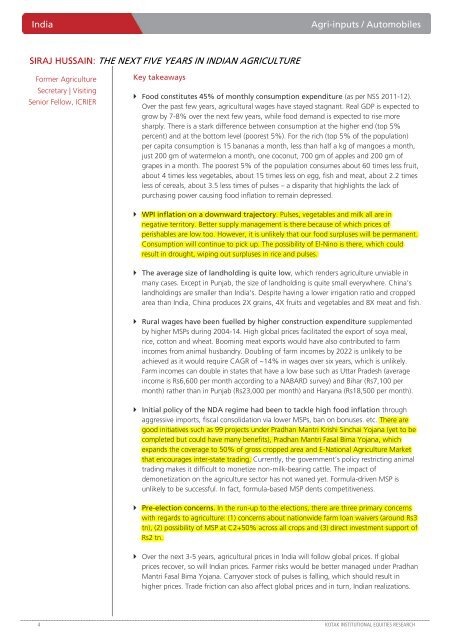Create successful ePaper yourself
Turn your PDF publications into a flip-book with our unique Google optimized e-Paper software.
India<br />
Agri-inputs / Automobiles<br />
SIRAJ HUSSAIN: THE NEXT FIVE YEARS IN INDIAN AGRICULTURE<br />
Former Agriculture<br />
Secretary | Visiting<br />
Senior Fellow, ICRIER<br />
Key takeaways<br />
Food constitutes 45% of monthly consumption expenditure (as per NSS 2011-12).<br />
Over the past few years, agricultural wages have stayed stagnant. Real GDP is expected to<br />
grow by 7-8% over the next few years, while food demand is expected to rise more<br />
sharply. There is a stark difference between consumption at the higher end (top 5%<br />
percent) and at the bottom level (poorest 5%). For the rich (top 5% of the population)<br />
per capita consumption is 15 bananas a month, less than half a kg of mangoes a month,<br />
just 200 gm of watermelon a month, one coconut, 700 gm of apples and 200 gm of<br />
grapes in a month. The poorest 5% of the population consumes about 60 times less fruit,<br />
about 4 times less vegetables, about 15 times less on egg, fish and meat, about 2.2 times<br />
less of cereals, about 3.5 less times of pulses – a disparity that highlights the lack of<br />
purchasing power causing food inflation to remain depressed.<br />
WPI inflation on a downward trajectory. Pulses, vegetables and milk all are in<br />
negative territory. Better supply management is there because of which prices of<br />
perishables are low too. However, it is unlikely that our food surpluses will be permanent.<br />
Consumption will continue to pick up. The possibility of El-Nino is there, which could<br />
result in drought, wiping out surpluses in rice and pulses.<br />
The average size of landholding is quite low, which renders agriculture unviable in<br />
many cases. Except in Punjab, the size of landholding is quite small everywhere. China’s<br />
landholdings are smaller than India’s. Despite having a lower irrigation ratio and cropped<br />
area than India, China produces 2X grains, 4X fruits and vegetables and 8X meat and fish.<br />
Rural wages have been fuelled by higher construction expenditure supplemented<br />
by higher MSPs during 2004-14. High global prices facilitated the export of soya meal,<br />
rice, cotton and wheat. Booming meat exports would have also contributed to farm<br />
incomes from animal husbandry. Doubling of farm incomes by 2022 is unlikely to be<br />
achieved as it would require CAGR of ~14% in wages over six years, which is unlikely.<br />
Farm incomes can double in states that have a low base such as Uttar Pradesh (average<br />
income is Rs6,600 per month according to a NABARD survey) and Bihar (Rs7,100 per<br />
month) rather than in Punjab (Rs23,000 per month) and Haryana (Rs18,500 per month).<br />
Initial policy of the NDA regime had been to tackle high food inflation through<br />
aggressive imports, fiscal consolidation via lower MSPs, ban on bonuses. etc. There are<br />
good initiatives such as 99 projects under Pradhan Mantri Krishi Sinchai Yojana (yet to be<br />
completed but could have many benefits), Pradhan Mantri Fasal Bima Yojana, which<br />
expands the coverage to 50% of gross cropped area and E-National Agriculture Market<br />
that encourages inter-state trading. Currently, the government’s policy restricting animal<br />
trading makes it difficult to monetize non-milk-bearing cattle. The impact of<br />
demonetization on the agriculture sector has not waned yet. Formula-driven MSP is<br />
unlikely to be successful. In fact, formula-based MSP dents competitiveness.<br />
Pre-election concerns. In the run-up to the elections, there are three primary concerns<br />
with regards to agriculture: (1) concerns about nationwide farm loan waivers (around Rs3<br />
tn), (2) possibility of MSP at C2+50% across all crops and (3) direct investment support of<br />
Rs2 tn.<br />
Over the next 3-5 years, agricultural prices in India will follow global prices. If global<br />
prices recover, so will Indian prices. Farmer risks would be better managed under Pradhan<br />
Mantri Fasal Bima Yojana. Carryover stock of pulses is falling, which should result in<br />
higher prices. Trade friction can also affect global prices and in turn, Indian realizations.<br />
4 KOTAK INSTITUTIONAL EQUITIES RESEARCH
















